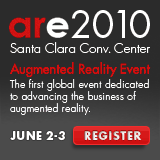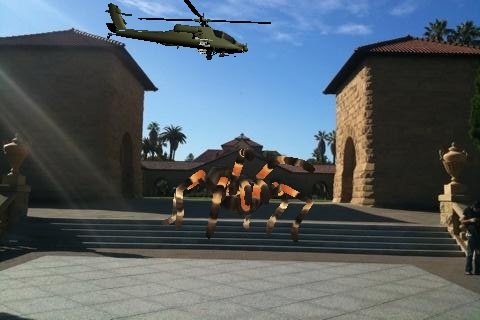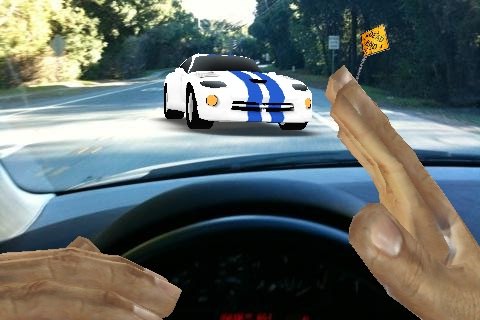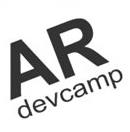 The Bay Area’s 2nd annual (?) Augmented Reality Developers Camp is officially on for Saturday Dec 4th 2010. This year’s event will be held in downtown San Francisco at GAFFTA, the Gray Area Foundation For The Arts. ARDevCamp is an open unconference organized by and for the local community of AR developers, artists and enthusiasts, with the participation and support of leading AR companies including Layar, Metaio, Qualcomm and FXPAL. I’m helping organize again this year, along with @chris23, @metaverseone, @anselm & @mikeliebhold. If you’re in the Bay Area and into augmented reality, you need to be there! More info on the wiki at ardevcamp.org
The Bay Area’s 2nd annual (?) Augmented Reality Developers Camp is officially on for Saturday Dec 4th 2010. This year’s event will be held in downtown San Francisco at GAFFTA, the Gray Area Foundation For The Arts. ARDevCamp is an open unconference organized by and for the local community of AR developers, artists and enthusiasts, with the participation and support of leading AR companies including Layar, Metaio, Qualcomm and FXPAL. I’m helping organize again this year, along with @chris23, @metaverseone, @anselm & @mikeliebhold. If you’re in the Bay Area and into augmented reality, you need to be there! More info on the wiki at ardevcamp.org
This is ar
je mixe ce soir!
Wednesday, November 3rd, 2010In honor of Facebook’s announcements today about making mobile more social, I’d like to remind you of this visionary portrayal of what it will be like when Facebook is truly mobile. Looks like we’ve got a long way to go.
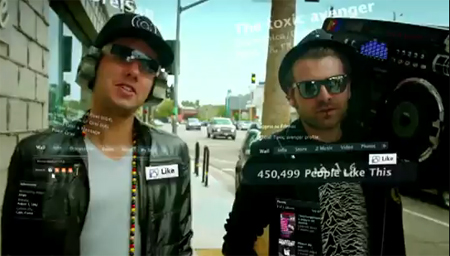
That’s right AR fans, it’s the Toxic Avenger feat. Orelsan performing last summer’s monster Internet dance hit, N’Importe Comment. So slip on your mindglasses, turn up the bass in your earplants, and prepare to “Like” this french fratboy fantasy from the future. Watch carefully, because this is a precious, fleeting snapshot of the way our connected culture felt, circa mid-2010. Someday, cyborg anthropologists are going to have a field day with this thing. Je mixe ce soir!
@ubistudio project: mobile AR layer for 2010 01SJ biennial
Wednesday, September 15th, 2010One of the goals of the @ubistudio is to actually do projects with new media technologies, not just talk about them. In that spirit, we made a mobile augmented reality experience for the 2010 01SJ Biennial that takes place this weekend, Sept 16-19, 2010.
It’s a fairly simple layer, developed on the Layar AR browser and featuring basic points of interest (POIs) for many of the public artworks and venues of the 01SJ festival. Here’s a screen shot of our layer in action on an iPhone 3Gs:
Among the many artworks featured are “Play Me I’m Yours“, ~20 street pianos created by artists Luke Jerram; Poetics of Dis-communication by Patrick Manning, and ZOROP by Ken Eklund and Annette Mees. You’ll also find the major venues and outdoor performances, to say nothing of the stops where you can catch the ZOROP Mexican Party Bus!
We submitted the layer to the Layar developer program, and it was approved earlier this week. If you’re at 01SJ and have a newer iPhone or Android phone, please check it out and let us know how you like it. You’ll need to download the free Layar app for your phone if you don’t have it already. Then just search for “01SJ” and you should be able to find it easily. All of the interesting points are in the downtown San Jose area, so if you’re not in that area you won’t see much ;-) If you have questions or feedback, ping us on Twitter: @ubistudio or just get involved by coming to our next Ubiquitous Media Studio meetup.
Beyond Augmented Reality: Ubiquitous Media
Saturday, June 19th, 2010Here are the slides I presented during my talk at ARE2010, the first Augmented Reality Event on June 3, 2010 in Santa Clara. Many thanks to all who attended, asked questions and gave feedback. For interested Bay Area folks, I will be organizing some face to face gatherings of the Ubiquitous Media Studio to explore the ideas raised here. The first one will be in July; follow @ubistudio on Twitter for further details.
ARE2010: kicking off the augmented reality summer of love
Tuesday, May 18th, 2010ARE2010 – the Augmented Reality Event – is just around the corner on June 2-3. In case you missed the memo, this is going to be an outstanding conference! I’ll be giving a deep dive talk on Experience Design for AR, expanding on what I presented at Web2Expo earlier this month. More importantly, there will be over 80 great speakers from the AR world, including keynotes by los luminarios Bruce Sterling, Will Wright, Jesse Schell and Blaise Aguera. Don’t miss this, seriously. And when you register, use this ARE2010 special discount code: E195 to get the full 2 days for just $195. It’s a freakin’ bargain, folks. Be there.
my talk on mobile AR experience design at Web2Expo
Tuesday, April 27th, 2010I’m presenting a session at Web2Expo in San Francisco on May 4th, titled “Challenge, Drama & Social Engagement: Designing Mobile Augmented Reality Experiences“. Here’s the blurb:
Mobile augmented reality adds digital overlays and interactivity to the physical world using the sensors and display of your smartphone. Design of mobile AR experiences is complex and takes us well beyond the browser-based web. This session will give you a mix of practical knowledge and new ideas for creating AR experiences, drawing from web design, 3D graphics, games, architecture and stagecraft.
The next generation of mobile augmented reality applications will go well beyond simply overlaying points of interest, floating post-its and 3D models on the video display of your phone. Mobile AR is becoming a sophisticated medium for immersive games, situated storytelling, large-scale visualization, and artistic expression. The combination of physical presence, visual and audio media, sensor datastreams and social environments blended together with web services offers tremendous new creative possibilities. However, the design challenges of creating engaging, exciting and compelling experiences are quite significant.
Research on the design of technology-mediated experiences has shown that compelling experiences often involve a mixture of physical and mental challenge or self-expression, a sense of drama, sensory stimulation, and social interaction. These elements can give us a physical “buzz†by activating the release of adrenaline, endorphins and related neurochemicals.
Mobile AR puts us “where the action isâ€â€”in motion through the physical world, surrounded by other people, in a stimulating environment. AR applications additionally provide challenges, stories, information and communication. Factors that AR experience designers need to consider include:
- Goals of the AR experience
- Users’ cognitive model of the system
- Physical environment and context of the experience
- Social context of the experience
- Design of interaction models and experience mechanics
- Story, goals and outcomes
- Immersion and flow
- Design of visual and audio assets
- Non-player characters (“AIsâ€)
- Tracking and analytics
- Technical capabilities and limitations of the AR system
- Managing the production process (designing an AR experience has much in common with producing a movie on location)
Should be fun, ping me if you’re going to be at the conference!
join me at the eComm firehose next week?
Wednesday, April 14th, 2010Next week I’ll be at the Emerging Communications conference, eComm 2010 in San Francisco, and would love to connect if you are going. The organizers have pulled together an impressive roster of speakers in a rapid-fire single track format that will undoubtedly feel like a three day firehose of ideas. Of course I’m very interested in the AR-heavy Wednesday lineup, but am also looking forward to seeing folks like John Hagel, Ge Wang and Debbie Estrin. Ping me if you’re there, and keep an eye out for digital film geek @endurablegoods who will no doubt be wielding weapons of mass digitization.
If you’re in town, you may want to extend your 3-day fun pass by going to Reality Checked – What’s Next for Mobile Augmented Reality on Monday night, and the wonderful Dorkbot-SF on Wednesday night. I’m just sayin’.
experience design for locative media & AR
Thursday, December 3rd, 2009The next generation of mobile Augmented Reality applications will go well beyond simply overlaying points of interest, floating post-its and 3D models on the video display of your phone. Mobile AR is becoming a sophisticated medium for immersive games, situated storytelling, large-scale visualization, and artistic expression. The combination of physical presence, visual and audio media, sensor datastreams and social environments blended together with web services offers tremendous new creative possibilities. However, the design challenges of creating engaging, exciting and compelling experiences are quite significant. AR experience designers will draw fruitful inspiration and practical lessons from game design, 3D graphics, architecture and stagecraft, as well as the structure, linking, protocols and openness of the web.
Some of the best research to date on experience design for locative media experiences, was done at HP Labs as part of the Mobile Bristol collaboration. You might find these papers useful and applicable to AR design, as I have.
Technology Experiences: What Makes Them Compelling? Alison Kidd, 2000
Experience Design for Pervasive Computing, Richard Hull & Jo Reid
Experience Design Guidelines for Creating Situated Mediascapes, Reid et al, 2005
we’re wired to augment our world and our selves
Tuesday, December 1st, 2009Humans are driven to augment our reality, and to augment our own capabilities. It’s the way we’re wired; it’s what we do. From the earliest cave paintings to modern day urban graffiti, we overlay our world with expressions of our inner selves. Architecture, street signs, billboards, fashions — these are all visual and functional augmentations of the physical world. We extend our sensory and cognitive capabilities as well, creating tools that allow us to perceive phenomena beyond the ken of our normal senses — at extremes of scale, distance, time, frequency, complexity, sociality. “Augmented Reality” is simply the next technological framework for expressing the natural human propensity to augment our world and our selves.

